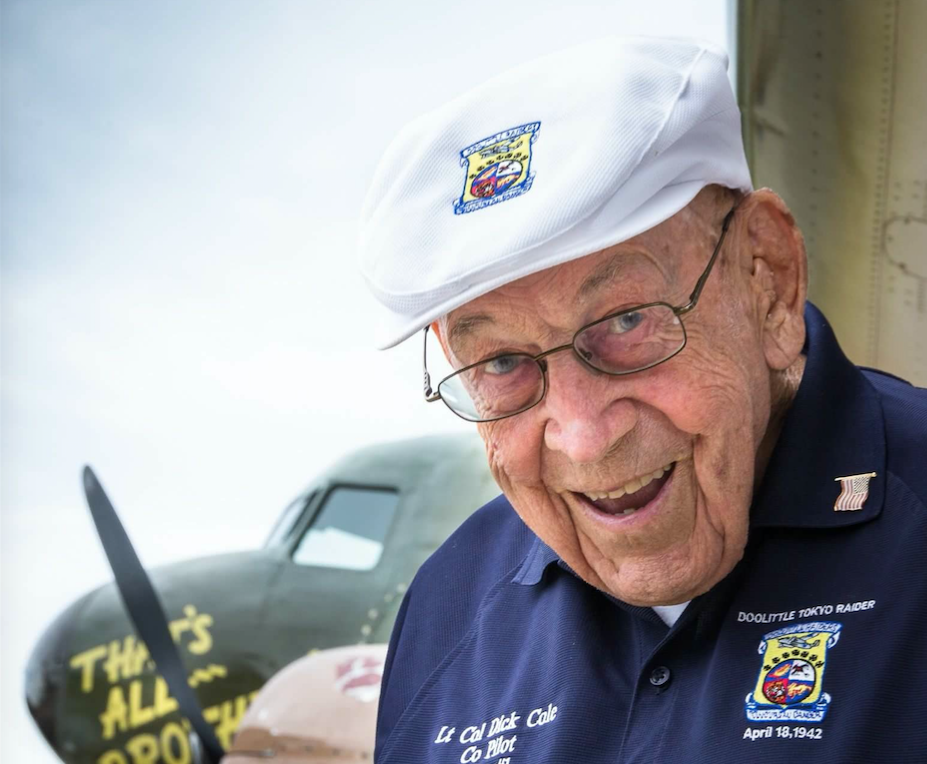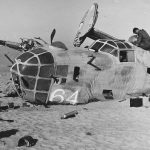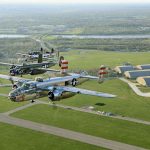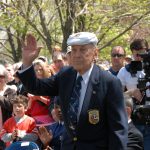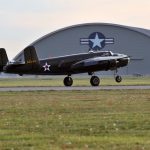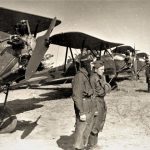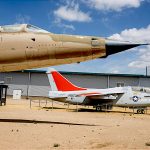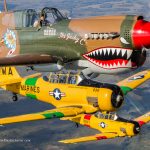By Pete Mecca
The Commemorative Air Force Dixie Wing World War II Days at Falcon Field lived up to expectations once again this past weekend. A gorgeous B-25 was on display to commemorate the 75th anniversary of the Doolittle Raid on Japan early in WWII. Reenactors, vendors, even operable B-25 gun turrets for the young and “very thin” young-at-heart enthusiasts were part of the program. The B-25, a P-51 and a Dauntless Dive Bomber plus various military trainers also offered rides.
In the vendor hangar, the last surviving Doolittle Raider, 101-year-old Lt. Col. Richard “Dick” Cole, enthusiastically signed copies of his book and posed for photos with an admiring throng. I’d briefly talked with Lt Col. Cole at another event, then penned an article on the Doolittle Raid, but this time a journalistic miracle unfolded. Cindy Cole Chal, the attractive, attentive and justifiably protective daughter of Lt. Col. Cole, recognized me from our first meeting and asked if I would like to join Sue Verhoef from the Atlanta History Center for Verhoef’s scheduled interview with her father Sunday morning.
No twisting of my arm was required. I’ve known Sue Verhoef several years. Her Atlanta History Center display was set up near our Atlanta WWII Round Table exhibit, so I made a beeline for Verhoef’s table to ask if she was agreeable to my requested intrusion. She happily agreed.
Since the interview was Sue’s show, my questions for Lt. Col. Cole were limited but based on a sound knowledge of the Doolittle Raid. The sole survivor’s physical health at 101 is still good yet waning, but his mental sharpness, eagerness, and wit are firmly intact. In short, Lt. Col. Cole was a real hoot! The questions and answers are forthright with insignificant editing for clarification.
THE INTERVIEW
VerhoefSue: What did you have for breakfast, Colonel?
Cole: Let’s see if I can remember. Oh, eggs and biscuits.
Verhoef: Did you sell all your books yesterday?
Cole: Yes, I did.
Verhoef: Thank you for coming, Colonel.
Cole: Thank you for having me.
Verhoef: May we have your full name?
Cole: Richard E. “Dick” Cole. I was born in Dayton, Ohio, on Sept. 7, 1915.
Verhoef: Tell us about your background, your childhood.
Cole: Well, I was fortunate to be born into a good family arrangement, I was number five of the children. I grew up with good schools and a great high school. I would have to say it was a happy environment. For some reason, I thought of myself as a happy child.
Verhoef: You were interested in aviation before the war. Why?
Cole: When I was old enough to ride through the neighborhood on my bike by myself, I guess about 10 years old, I’d ride down to the Army airfield near Dayton. I would sit on the river levee and watch what’s going on without realizing who was performing on a particular day.
Mecca: You mean barnstormers?
Cole: Yes, it was all very interesting. There was an annual airshow in October, and I always went to that. Anyway, I made up my mind to either be an Air Corps pilot or a forest ranger.
Verhoef: How did everything unfold?
Cole: Well, I tried to map out a plan on how to get there, to be a pilot, but later on I realized that wasn’t much of a plan. The main reason I wanted to be an Army pilot, once a month Wright Field sent a Curtiss Hawk to hover over an Army truck, then it would quickly bank into the base. It was payday! That sounded good to me, plus I wanted to go after the bad guys.
Verhoef: What made you decide to join the military?
Cole: Between middle school and high school they offered an aviation course. I attended that, was third out of 33 grads. For those interested, they gave us a chance to drop out of high school, then attend another course. Quite a few of us did. The course was more toward aircraft mechanics, tearing apart a Liberty engine, there were nine of us, and we had to put it back together. The teacher had rigged a system to crank the propeller to see if the ignition system was installed correctly, but we couldn’t really start it.
Verhoef: And after that?
Cole: I spent a lot of time looking for a job! People today don’t realize how hard it was to find a job back then. Anyway, I found a worthwhile job, $75 a month plus room and board. I did that for a couple of years, then started college. Before college I went to Wright Field for training in the Army, I passed all the tests, but in the end they turned me down. See, the Air Corps was under the Signal Corps, and they didn’t take anyone in need of medical attention. I had two bad teeth and a set of tonsils, so I was turned down. After that, I figured I should go on to college and learn all I could about Smokey the Bear.
Verhoef: So how did you get into aviation?
Cole: I started college, but between my sophomore and junior year I got the word that Uncle Sam had this program, he would pay for you to get a pilot’s license. But if you qualified and received your license, you had to make yourself available for any kind of emergency.
Verhoef: So, that’s how it started?
Cole: Yeah, I did that. I was working during the summer in my job and went to …. wait, let’s back up a minute. I got my pilot’s license during September of ’41 and …
Mecca: On what type of aircraft did you train?
Cole: A Taylorcraft. So, I graduated, then they told me to wait. Well, by November I got tired of waiting and went to enlist.
Verhoef: How did your family feel about you enlisting?
Cole: They were glad to get rid of me. So, no objections from family members. I went to Fort Thomas for a month, then got orders for St. Louis. I was lucky enough to get through that program, then ended up at Randolph Air Force Base. After graduation, a few of us were sent to Pendleton, Ore., to join the 17th Bomber Group. We trained here and there and ended up with a fairly good bomb group.
Verhoef: How did you find out about a secret mission needing volunteers?
Cole: Well, at Pendleton we were all copilots and I was crewed up with a gentleman that had quite a lot of time in B-25s, that’s how we welded into a squadron. When I arrived at Pendleton the group made a move to Spokane, Wash. We spent the summer there, then got orders for Columbia, S.C. We trained with the Army Air Corps plus ground forces. On Dec. 6, 1941, we were at March Field on our way back to Pendleton. Of course, the next morning on Dec. 7, 1941 the war started. Back at Pendleton, they changed our bomb racks to accommodate submarine bombing. We were on submarine patrol along the coasts of Oregon and Washington until February of ’42. Then we got orders to return to Columbia. We were at a newer airbase, it wasn’t quite finished, mostly mud and water. We lived in tents. Each squadron had an information board that we were required to examine daily. One day we read they needed pilots for a secret mission. Well, our instructor was a great guy, a really good pilot, and he put his name on the list. I thought that was a pretty good idea, so I put my name on the list, even if I didn’t think it was such a good idea after I did it.
Verhoef: Why were you chosen for the mission?
Cole: They chose the pilots, don’t know how they did it, but we started training for the mission. Well, the instructor I trained with became ill, so I needed a pilot to fly with. I went to the Ops Room asking questions and they said, “You still want to go?,” and I said, “Yeah,” so they told me, “The old man is coming in this afternoon. He’ll take care of it.” Anyway, Jimmy Doolittle showed up about an hour after that. They told him I’d been chosen as his copilot, he said, “Fine,” and that was that.
Mecca: Did you know Doolittle was “the old man,” your leader?
Cole: Yes. I was fortunate to know who he was and what kind of pilot he was because I’d seen Doolittle perform at airshows.
Verhoef: What do you remember about your training at Eglin Field, what stands out?
Cole: Doolittle wanted us to have 50 hours of training, but with launch scheduled for April 19 he only had 90 days to get us ready. We ended up with about 30 hours of training. Turned out that was enough to do what we needed to do, and we did.
Verhoef: Tell us about your trip to the USS Hornet, the carrier to carry you to your destination. Did you watch them lift the B-25s onto the deck?
Cole: We were in San Francisco. The Navy has that kind of equipment, big cranes, everything was hooked up and went well.
Verhoef: Tell us about the crossing. Were you ever on a ship before and did you get seasick?
Cole: No, I’d never been on a ship before, and no, I didn’t get seasick. It was, by the way, the first time I’d even seen an ocean.
Verhoef: Did you know you were going to take off from a carrier?
Cole: Well, it was pretty obvious we would be taking off from a carrier, but we didn’t figure Japan as the target. We figured we’d take off and land on some island and get on with fighting the war. But two days out we were told our target was Japan. There was a lot of jubilation, a lot jumping up and down and hollering, but after that things got real quiet, that too pretty obvious as to why. Doolittle said if anyone wanted to get out, to back out, there would be no repercussions. Nobody backed out.
Verhoef: Tell us about the day of launch, when you got the word to “go.”
Cole: By that time we had a pretty good chunk out of our brains with all the training, so we truthfully didn’t think it posed a great problem. We had navigation, classroom instruction, so with everything considered we had the training to do the job.
Verhoef: What was it like to launch? Was it a scary moment?
Cole: Surprisingly enough, with our training we were OK. The only concern was the weather, but that turned out OK. We figured the launch would be challenging, so we positioned a B-25 in the middle of the deck, which gave us 6 feet of clearance on both sides. We painted a white line on our left gear and one for the nose wheel so we could steer down those lines and it worked OK. We didn’t consider the launch a big problem.
Mecca: Would a night launch have been considered?
Cole: Doolittle considered a night launch possible. He approached the Navy with the idea, but they wouldn’t buy it. They feared one of the bombers would drift over and hit the island (command structure) and put the carrier out of commission. We only had four carriers in the Pacific at the time and the Navy couldn’t afford to lose one.
Verhoef: What was the mood of the crew during the flight to Japan?
Cole: We didn’t get keyed up or anything, we didn’t have any Japanese aircraft try to intercept us. When we got to Japan it was like flying into Miami Beach. People were playing on the beach and working on their boats, all kinds of activity. And we hadn’t made any mistakes so we continued on.
Verhoef: Then you were en route to China?
Cole: Well, once we dropped our bombs we were, but it wouldn’t have done any good to have a base to land on in China. The entire area was socked in, couldn’t see a thing, and we didn’t know where we were.
Verhoef: When did you get the orders to bail out?
Cole: Well, the whole flight took 13 hours … four to Japan, nine hours across the water to China. No particular or dramatic things happened. We ended up thinking about what could happen, especially after Hank, our navigator, handed me a note saying we were going to end up about 180 miles short of China. We didn’t know what to think about that. But we got to China with fuel to spare, a tailwind helped us.
Mecca: No homing beacon?
Cole: No. An aircraft with a homing station was supposed to basically “greet” us into China, but their plane crashed en route and killed all the occupants so we lost the radio equipment. We didn’t think of it at the time of launch, but as we circled the carrier and looked down at the “heads-up” board for our course to China, we knew we had separated ourselves from civilization. In our zeal to make the bomber as light as possible to take on more fuel, we tossed out all the long range radio equipment. The only communications we had was a command set, a range of about 45 miles. Had there been an emergency, 16 B-25s would have been floating around in the Pacific.
Verhoef: Had you trained for a bailout? Had you used a parachute before?
Cole: No. And not one since.
Pete: Colonel, what did you think of the B-25?
Cole: The only thing I can say about that is, all through training I drove around in a Model A Ford. Going from a Model A Ford into a Mitchell B-25 bomber is like crawling into a Mustang. Great aircraft.
Mecca: What was your altitude en route to Japan?
Cole: About 200 feet above the water. We stayed at 200 feet, except climbing to 1,500 feet to bomb and later to bail out. Other than that, we stayed at 200 feet.
Mecca: What was your target?
Cole: Our target was northwest Tokyo because we carried incendiaries so we could light up Tokyo for the rest of the bombers, like a reference point.
Mecca: Did you dodge any flak or enemy fighters?
Cole: No fighters, but pulling off the bombing run we had flak coming up at us … bounced us around a bit.
Mecca: After you bailed out, you landed in a tree, correct?
Cole: Well, that was the best landing in that situation. The terrain was very mountainous, so I was pretty lucky and waited until morning to cut myself loose. Just a few scratches. Although I found out later the Army doesn’t hand out Purple Hearts for self-inflected injuries. I was luckier than Doolittle though, he landed neck-deep in a pile of manure.
Mecca: Your entire crew made it back, correct?
Cole: The whole crew survived. Some of the Raiders returned to the states, but 26 of us stayed. Six of us went to the CBI Theatre (China-India-Burma). I got checked out on a C-47 and flew them for about 14 months, including the Hump (flying across the Himalayan Mountains).
Verhoef: Your last comments, sir?
Cole: When I think about it, the mission was not a highly dangerous affair. You could do something about it if there was a problem. But, looking back, I’d say we were pretty lucky.
When Lt. Col. Cole found out I had served in Vietnam, he said, “There’s another time I was lucky.” I asked, ‘So, you were in Nam, too?’ Cole replied, “No, I was lucky that I didn’t have to go!”
In all, Lt. Col. Cole flew 21 different aircraft during his career. The last one a T-33 Shooting Star jet fighter. Of 80 Doolittle Raiders, 69 survived the mission, three were killed in action, eight were captured – three were executed by the Japanese, one died in captivity, four returned home after the war. Of the 28 Raiders who eventually flew in the CBI Theatre of Operations, five lost their lives. Nineteen Raiders flew in the Mediterranean Theatre, four were killed in action. Nine Raiders flew in Europe, one was lost. Of the 63 Doolittle Raiders who survived the war, 101-year-old Lt. Colonel Richard “Dick” Cole, is the sole survivor.
Many thanks to Cindy Cole Chal and Sue Verhoef for the opportunity to participate in an interview for the ages.
Pete Mecca is a Vietnam veteran. To read Pete’s stories visit www.aveteransstory.us
Editor’s note: According to the group’s official website, the Doolittle Tokyo Raiders was a group of 80 men from all walks of life who volunteered to fly a dangerous bombing raid over Japan. According to the website, the raid on Tokyo on April 18, 1942 provided a morale boost to both the American military and the public. It also proved to the Japanese high command that their home islands were not invulnerable to American attacks, causing them to shift vital resources to their defense. Two months later that decision would play a role in the outcome of the Battle of Midway, the American victory that would begin to turn the tide in the Pacific War.







